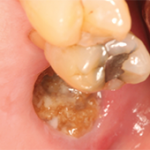Clinicians can assess patients’ risk through use of calculators, such as the Fracture Risk Assessment Tool (FRAX), which estimates patients’ 10-year risk of major hip fractures and major osteoporotic fractures more generally, based on features such as sex, body mass index, parental hip fracture, smoking, alcohol intake and other causes of secondary osteoporosis.8
However, patients should ideally receive bone mineral density testing in addition to a test such as FRAX, so clinicians have more complete information to weigh the risk of fracture against the risks of osteoporotic prevention therapy. The guideline also underscores the fact that FRAX alone is not reliable for assessing osteoporotic fracture risk in patients under 40, so bone mineral density testing is especially important for these patients.
“The most important message is that if you are putting someone on longterm glucocorticoid therapy, you should definitely assess their fracture risk,” Dr. Russell says. “It doesn’t mean that everybody needs a medication, but you should make the assessment.”
Even after an initial assessment, patients at moderate to high risk who opt not to start therapy should be reassessed frequently. Dr. Russell points out that even for patients who have never taken glucocorticoids, clinicians need to periodically assess bone health in at-risk patients, such as postmenopausal women.
“My takeaway from this guideline is that we really want people to be treated—it’s a very strong recommendation for people to get treated if they are high risk or very high risk,” says Dr. Humphrey.
Dr. Humphrey also notes that we have fewer data on patients at moderate risk of glucocorticoid-induced osteoporotic fracture because such patients are generally not included in glucocorticoid-induced osteoporosis studies, which is partly why these recommendations are conditional instead of strong. “But we really want people at moderate risk to be treated, too,” she says.
 Ruth Jessen Hickman, MD, is a graduate of the Indiana University School of Medicine. She is a freelance medical and science writer living in Bloomington, Ind.
Ruth Jessen Hickman, MD, is a graduate of the Indiana University School of Medicine. She is a freelance medical and science writer living in Bloomington, Ind.
References
- Humphrey MB, Russel L, Danila, M, et al. 2022 American College of Rheumatology Guideline for the Prevention and Treatment of Glucocorticoid-Induced Osteoporosis. [These recommendations are included in a full manuscript, which was submitted, peer review pending, for publication in Arthritis & Rheumatology and Arthritis Care and Research.] https://rheumatology.org/glucocorticoid-induced-osteoporosis-guideline.
- Huette P, Abou-Arab O, Djebara AE, et al. Risk factors and mortality of patients undergoing hip fracture surgery: A one-year follow-up study. Sci Rep. 2020 Jun;10(1):9607.
- American College of Rheumatology Task Force on Osteoporosis Guidelines. Recommendations for the prevention and treatment of glucocorticoid-induced osteoporosis. Arthritis Rheum. 1996 Nov;39:1791–1801.
- Buckley L, Guyatt G, Fink HA, et al. 2017 American College of Rheumatology Guideline for the Prevention and Treatment of Glucocorticoid-Induced Osteoporosis. Arthritis Care Res (Hoboken). 2017 Aug;69(8):1095–1110. Erratum: Arthritis Care Res (Hoboken). 2017 Nov;69(11):1776.
- Tu KN, Lie JD, Wan CKV, et al. Osteoporosis: A review of treatment options. P T. 2018 Feb;43(2):92–104.
- Saag KG, Shane E, Boonen S, et al. Teriparatide or alendronate in glucocorticoidinduced osteoporosis. N Engl J Med. 2007 Nov;357(20):2028–2039.
- Anastasilakis AD, Makras P, Yavropoulou MP, et al. Denosumab discontinuation and the rebound phenomenon: A narrative review. J Clin Med. 2021 Jan;10(1):152.
- El Miedany Y. FRAX: Re-adjust or re-think. Arch Osteoporos. 2020 Sep;15(1):150.

